XYZ Ltd: Impact of Workplace Changes on Employees' Work
VerifiedAdded on 2020/01/28
|28
|6085
|164
Report
AI Summary
This report investigates the impact of changes in workplace environment and culture on employees, focusing on XYZ Ltd's experience with a new office setup. The study explores the rationale, aims, objectives, research questions, and hypothesis related to this impact. It includes a comprehensive literature review covering workplace environment, culture, and their characteristics, as well as changes in workplace culture and their effects. The methodology section details the research philosophy (positivism), design, approach, data collection, and analysis techniques. The report analyzes both quantitative and qualitative data to draw conclusions and provide recommendations for managing these processes in SMEs. It also includes a reflective report and a detailed reference list.
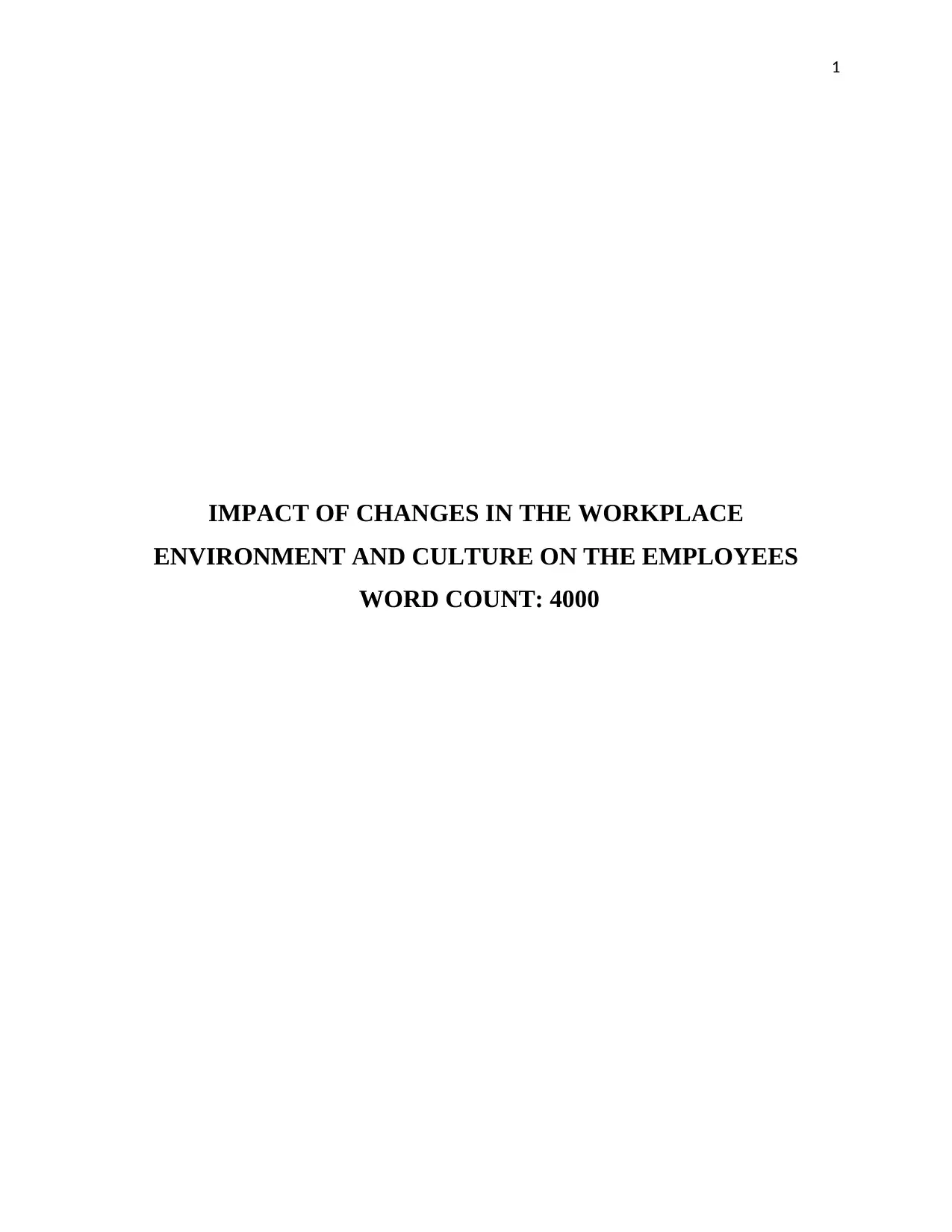
1
IMPACT OF CHANGES IN THE WORKPLACE
ENVIRONMENT AND CULTURE ON THE EMPLOYEES
WORD COUNT: 4000
IMPACT OF CHANGES IN THE WORKPLACE
ENVIRONMENT AND CULTURE ON THE EMPLOYEES
WORD COUNT: 4000
Paraphrase This Document
Need a fresh take? Get an instant paraphrase of this document with our AI Paraphraser
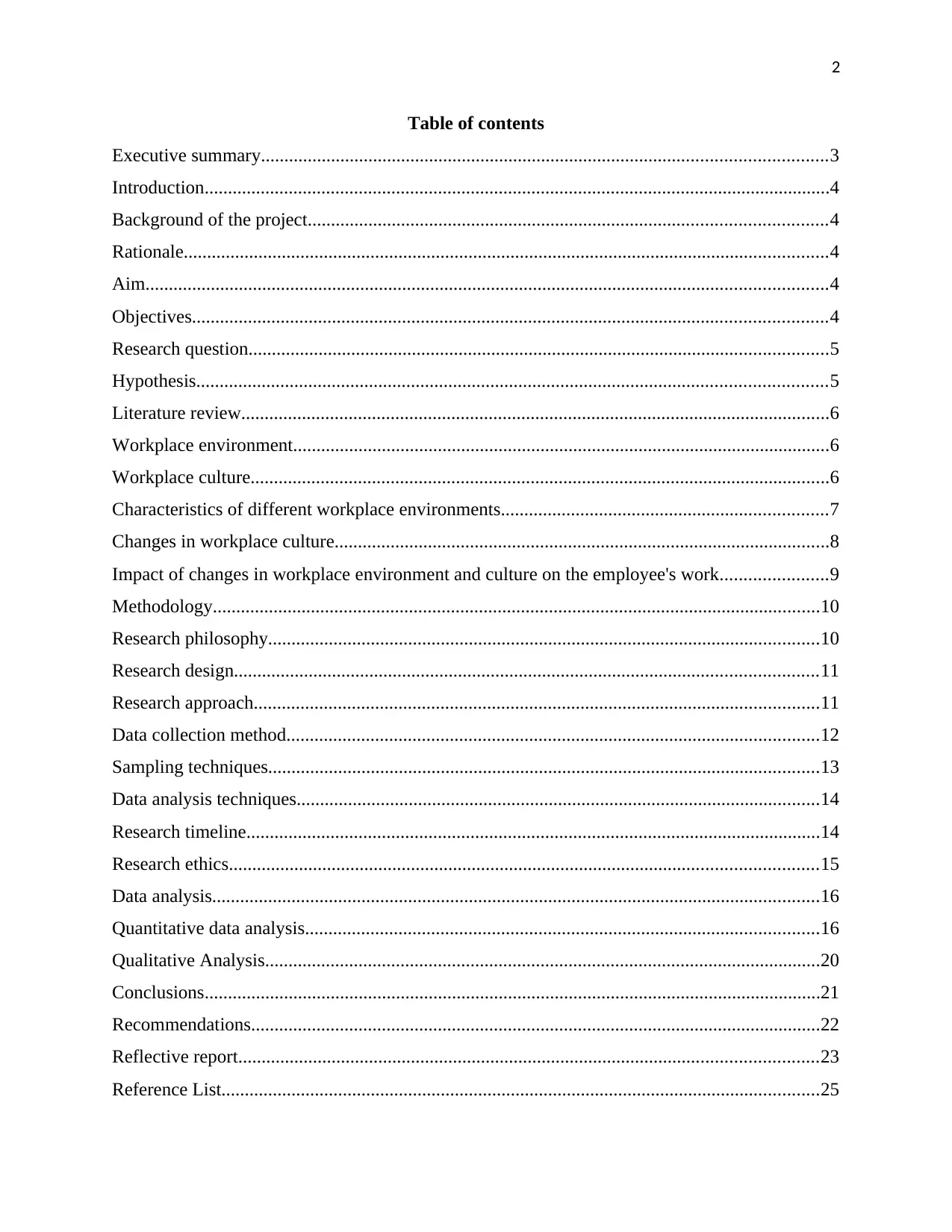
2
Table of contents
Executive summary.........................................................................................................................3
Introduction......................................................................................................................................4
Background of the project...............................................................................................................4
Rationale..........................................................................................................................................4
Aim..................................................................................................................................................4
Objectives........................................................................................................................................4
Research question............................................................................................................................5
Hypothesis.......................................................................................................................................5
Literature review..............................................................................................................................6
Workplace environment...................................................................................................................6
Workplace culture............................................................................................................................6
Characteristics of different workplace environments......................................................................7
Changes in workplace culture..........................................................................................................8
Impact of changes in workplace environment and culture on the employee's work.......................9
Methodology..................................................................................................................................10
Research philosophy......................................................................................................................10
Research design.............................................................................................................................11
Research approach.........................................................................................................................11
Data collection method..................................................................................................................12
Sampling techniques......................................................................................................................13
Data analysis techniques................................................................................................................14
Research timeline...........................................................................................................................14
Research ethics..............................................................................................................................15
Data analysis..................................................................................................................................16
Quantitative data analysis..............................................................................................................16
Qualitative Analysis.......................................................................................................................20
Conclusions....................................................................................................................................21
Recommendations..........................................................................................................................22
Reflective report............................................................................................................................23
Reference List................................................................................................................................25
Table of contents
Executive summary.........................................................................................................................3
Introduction......................................................................................................................................4
Background of the project...............................................................................................................4
Rationale..........................................................................................................................................4
Aim..................................................................................................................................................4
Objectives........................................................................................................................................4
Research question............................................................................................................................5
Hypothesis.......................................................................................................................................5
Literature review..............................................................................................................................6
Workplace environment...................................................................................................................6
Workplace culture............................................................................................................................6
Characteristics of different workplace environments......................................................................7
Changes in workplace culture..........................................................................................................8
Impact of changes in workplace environment and culture on the employee's work.......................9
Methodology..................................................................................................................................10
Research philosophy......................................................................................................................10
Research design.............................................................................................................................11
Research approach.........................................................................................................................11
Data collection method..................................................................................................................12
Sampling techniques......................................................................................................................13
Data analysis techniques................................................................................................................14
Research timeline...........................................................................................................................14
Research ethics..............................................................................................................................15
Data analysis..................................................................................................................................16
Quantitative data analysis..............................................................................................................16
Qualitative Analysis.......................................................................................................................20
Conclusions....................................................................................................................................21
Recommendations..........................................................................................................................22
Reflective report............................................................................................................................23
Reference List................................................................................................................................25
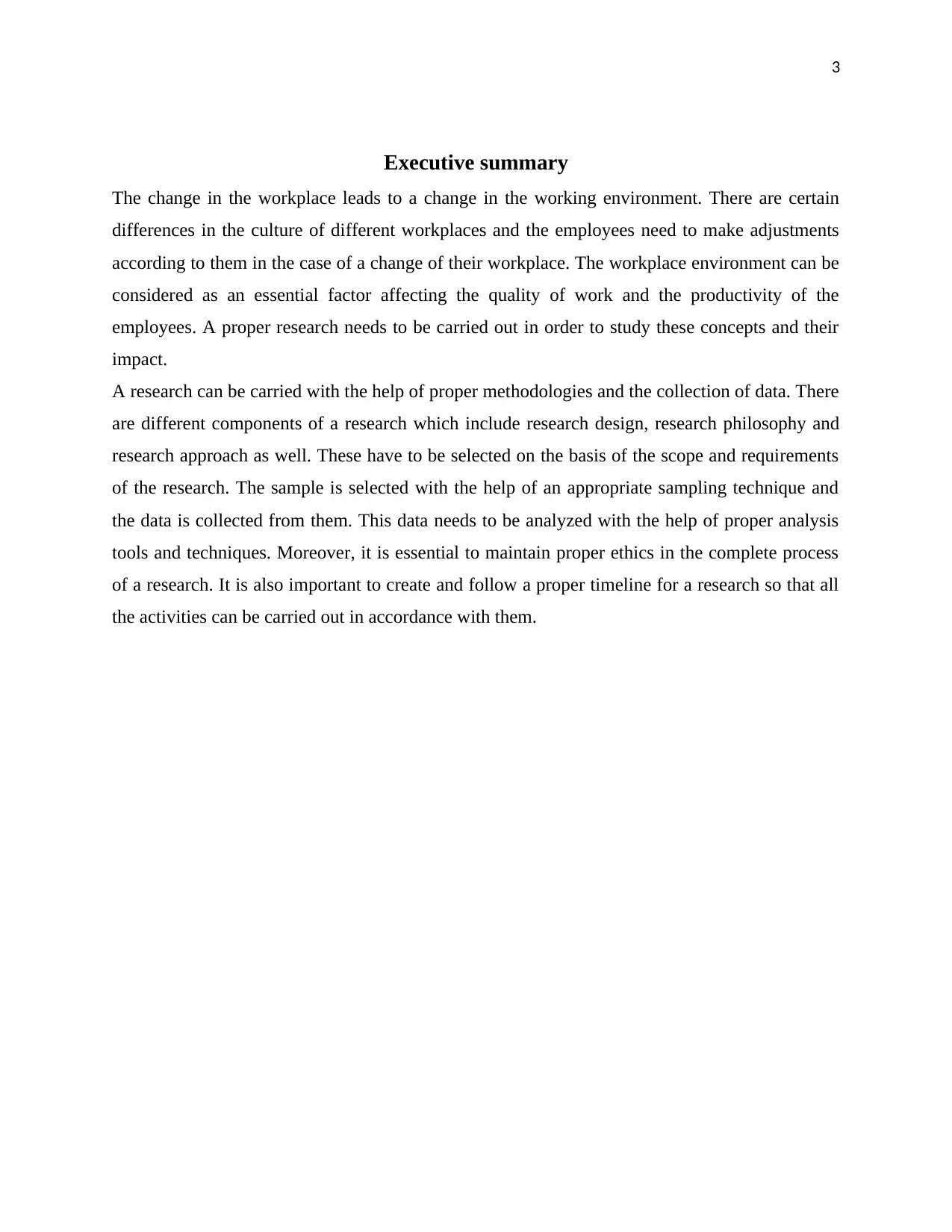
3
Executive summary
The change in the workplace leads to a change in the working environment. There are certain
differences in the culture of different workplaces and the employees need to make adjustments
according to them in the case of a change of their workplace. The workplace environment can be
considered as an essential factor affecting the quality of work and the productivity of the
employees. A proper research needs to be carried out in order to study these concepts and their
impact.
A research can be carried with the help of proper methodologies and the collection of data. There
are different components of a research which include research design, research philosophy and
research approach as well. These have to be selected on the basis of the scope and requirements
of the research. The sample is selected with the help of an appropriate sampling technique and
the data is collected from them. This data needs to be analyzed with the help of proper analysis
tools and techniques. Moreover, it is essential to maintain proper ethics in the complete process
of a research. It is also important to create and follow a proper timeline for a research so that all
the activities can be carried out in accordance with them.
Executive summary
The change in the workplace leads to a change in the working environment. There are certain
differences in the culture of different workplaces and the employees need to make adjustments
according to them in the case of a change of their workplace. The workplace environment can be
considered as an essential factor affecting the quality of work and the productivity of the
employees. A proper research needs to be carried out in order to study these concepts and their
impact.
A research can be carried with the help of proper methodologies and the collection of data. There
are different components of a research which include research design, research philosophy and
research approach as well. These have to be selected on the basis of the scope and requirements
of the research. The sample is selected with the help of an appropriate sampling technique and
the data is collected from them. This data needs to be analyzed with the help of proper analysis
tools and techniques. Moreover, it is essential to maintain proper ethics in the complete process
of a research. It is also important to create and follow a proper timeline for a research so that all
the activities can be carried out in accordance with them.
⊘ This is a preview!⊘
Do you want full access?
Subscribe today to unlock all pages.

Trusted by 1+ million students worldwide
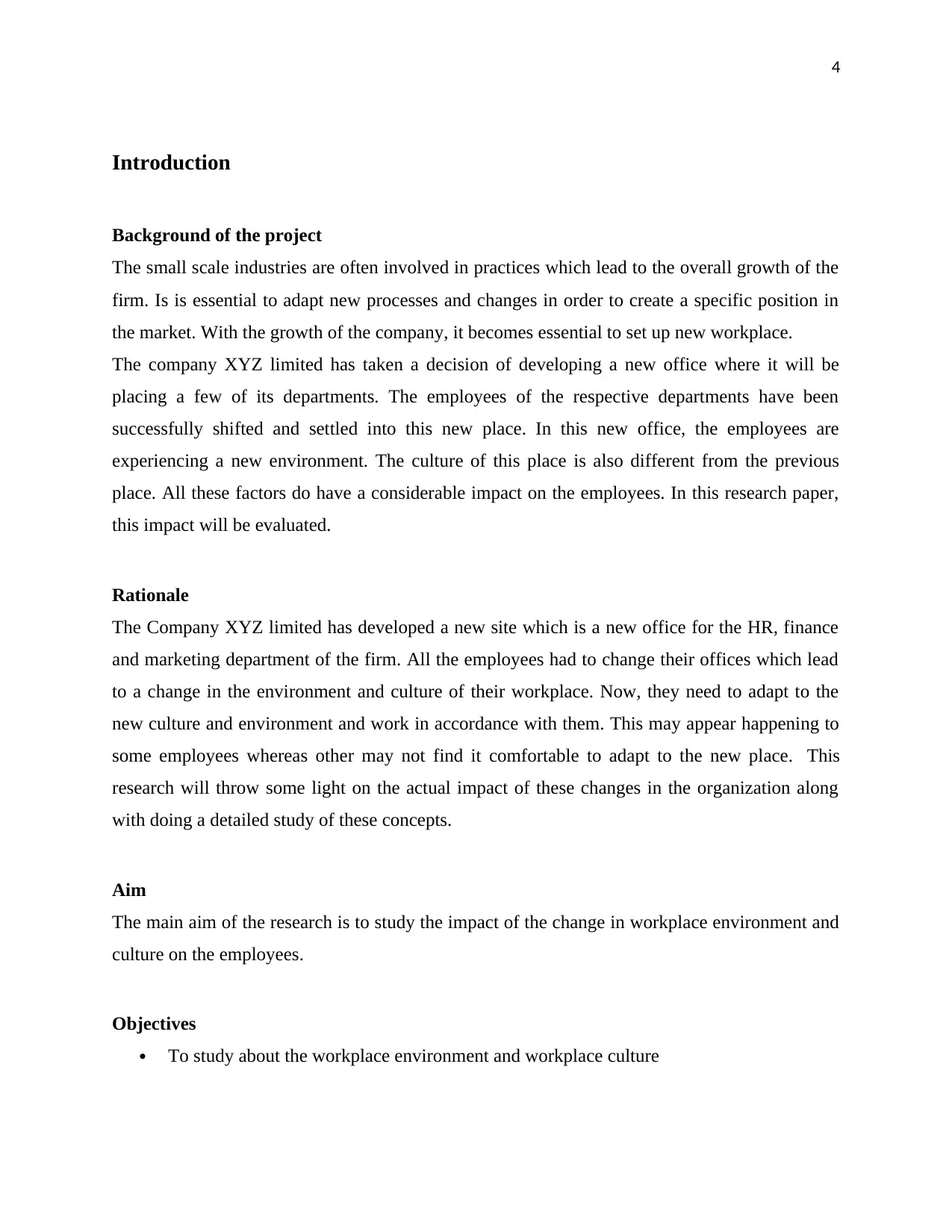
4
Introduction
Background of the project
The small scale industries are often involved in practices which lead to the overall growth of the
firm. Is is essential to adapt new processes and changes in order to create a specific position in
the market. With the growth of the company, it becomes essential to set up new workplace.
The company XYZ limited has taken a decision of developing a new office where it will be
placing a few of its departments. The employees of the respective departments have been
successfully shifted and settled into this new place. In this new office, the employees are
experiencing a new environment. The culture of this place is also different from the previous
place. All these factors do have a considerable impact on the employees. In this research paper,
this impact will be evaluated.
Rationale
The Company XYZ limited has developed a new site which is a new office for the HR, finance
and marketing department of the firm. All the employees had to change their offices which lead
to a change in the environment and culture of their workplace. Now, they need to adapt to the
new culture and environment and work in accordance with them. This may appear happening to
some employees whereas other may not find it comfortable to adapt to the new place. This
research will throw some light on the actual impact of these changes in the organization along
with doing a detailed study of these concepts.
Aim
The main aim of the research is to study the impact of the change in workplace environment and
culture on the employees.
Objectives
To study about the workplace environment and workplace culture
Introduction
Background of the project
The small scale industries are often involved in practices which lead to the overall growth of the
firm. Is is essential to adapt new processes and changes in order to create a specific position in
the market. With the growth of the company, it becomes essential to set up new workplace.
The company XYZ limited has taken a decision of developing a new office where it will be
placing a few of its departments. The employees of the respective departments have been
successfully shifted and settled into this new place. In this new office, the employees are
experiencing a new environment. The culture of this place is also different from the previous
place. All these factors do have a considerable impact on the employees. In this research paper,
this impact will be evaluated.
Rationale
The Company XYZ limited has developed a new site which is a new office for the HR, finance
and marketing department of the firm. All the employees had to change their offices which lead
to a change in the environment and culture of their workplace. Now, they need to adapt to the
new culture and environment and work in accordance with them. This may appear happening to
some employees whereas other may not find it comfortable to adapt to the new place. This
research will throw some light on the actual impact of these changes in the organization along
with doing a detailed study of these concepts.
Aim
The main aim of the research is to study the impact of the change in workplace environment and
culture on the employees.
Objectives
To study about the workplace environment and workplace culture
Paraphrase This Document
Need a fresh take? Get an instant paraphrase of this document with our AI Paraphraser
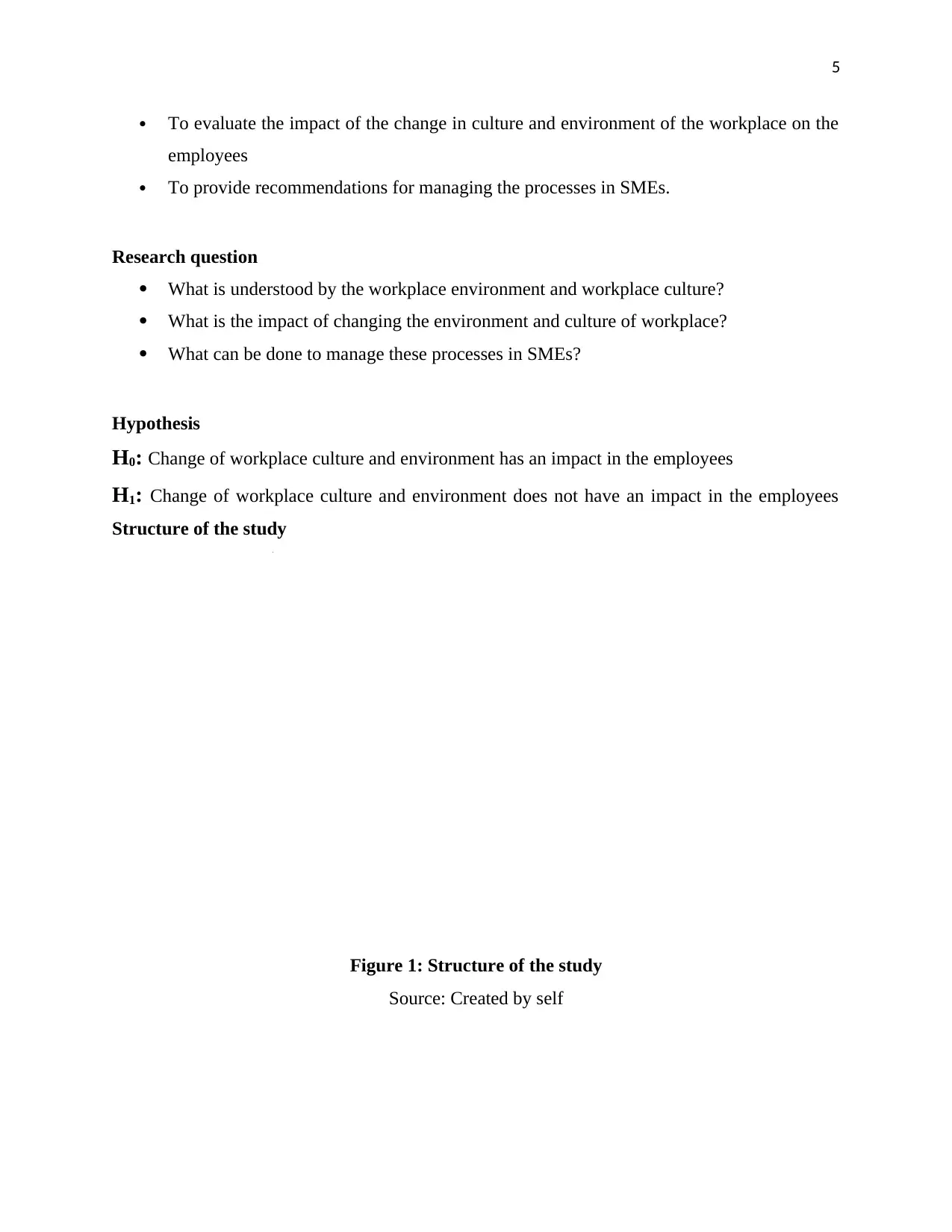
5
To evaluate the impact of the change in culture and environment of the workplace on the
employees
To provide recommendations for managing the processes in SMEs.
Research question
What is understood by the workplace environment and workplace culture?
What is the impact of changing the environment and culture of workplace?
What can be done to manage these processes in SMEs?
Hypothesis
H0: Change of workplace culture and environment has an impact in the employees
H1: Change of workplace culture and environment does not have an impact in the employees
Structure of the study
Figure 1: Structure of the study
Source: Created by self
IntroductionLiteratureReviewResearchMethodologyDataAnalysisConclusionsRecommendationsReflectiveReport
To evaluate the impact of the change in culture and environment of the workplace on the
employees
To provide recommendations for managing the processes in SMEs.
Research question
What is understood by the workplace environment and workplace culture?
What is the impact of changing the environment and culture of workplace?
What can be done to manage these processes in SMEs?
Hypothesis
H0: Change of workplace culture and environment has an impact in the employees
H1: Change of workplace culture and environment does not have an impact in the employees
Structure of the study
Figure 1: Structure of the study
Source: Created by self
IntroductionLiteratureReviewResearchMethodologyDataAnalysisConclusionsRecommendationsReflectiveReport
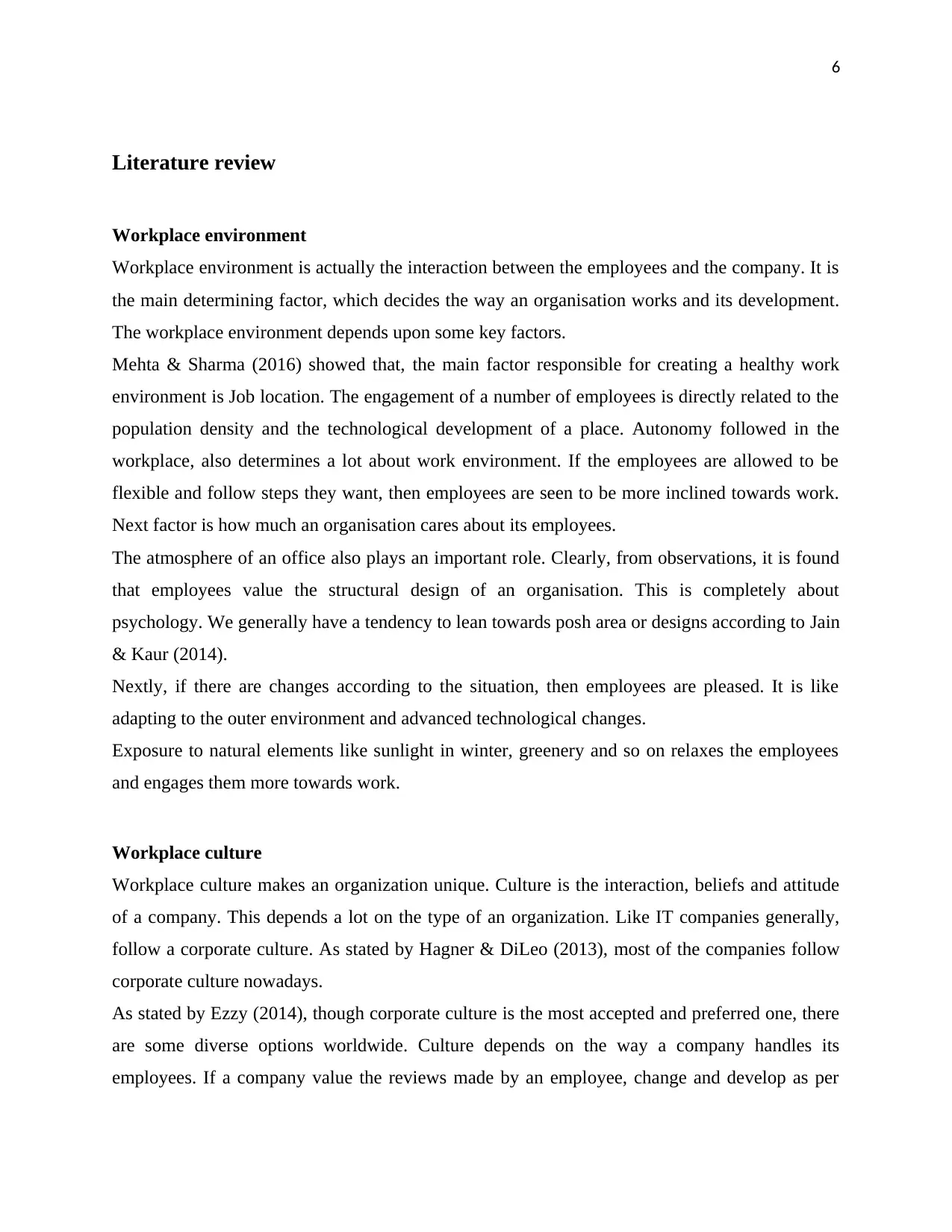
6
Literature review
Workplace environment
Workplace environment is actually the interaction between the employees and the company. It is
the main determining factor, which decides the way an organisation works and its development.
The workplace environment depends upon some key factors.
Mehta & Sharma (2016) showed that, the main factor responsible for creating a healthy work
environment is Job location. The engagement of a number of employees is directly related to the
population density and the technological development of a place. Autonomy followed in the
workplace, also determines a lot about work environment. If the employees are allowed to be
flexible and follow steps they want, then employees are seen to be more inclined towards work.
Next factor is how much an organisation cares about its employees.
The atmosphere of an office also plays an important role. Clearly, from observations, it is found
that employees value the structural design of an organisation. This is completely about
psychology. We generally have a tendency to lean towards posh area or designs according to Jain
& Kaur (2014).
Nextly, if there are changes according to the situation, then employees are pleased. It is like
adapting to the outer environment and advanced technological changes.
Exposure to natural elements like sunlight in winter, greenery and so on relaxes the employees
and engages them more towards work.
Workplace culture
Workplace culture makes an organization unique. Culture is the interaction, beliefs and attitude
of a company. This depends a lot on the type of an organization. Like IT companies generally,
follow a corporate culture. As stated by Hagner & DiLeo (2013), most of the companies follow
corporate culture nowadays.
As stated by Ezzy (2014), though corporate culture is the most accepted and preferred one, there
are some diverse options worldwide. Culture depends on the way a company handles its
employees. If a company value the reviews made by an employee, change and develop as per
Literature review
Workplace environment
Workplace environment is actually the interaction between the employees and the company. It is
the main determining factor, which decides the way an organisation works and its development.
The workplace environment depends upon some key factors.
Mehta & Sharma (2016) showed that, the main factor responsible for creating a healthy work
environment is Job location. The engagement of a number of employees is directly related to the
population density and the technological development of a place. Autonomy followed in the
workplace, also determines a lot about work environment. If the employees are allowed to be
flexible and follow steps they want, then employees are seen to be more inclined towards work.
Next factor is how much an organisation cares about its employees.
The atmosphere of an office also plays an important role. Clearly, from observations, it is found
that employees value the structural design of an organisation. This is completely about
psychology. We generally have a tendency to lean towards posh area or designs according to Jain
& Kaur (2014).
Nextly, if there are changes according to the situation, then employees are pleased. It is like
adapting to the outer environment and advanced technological changes.
Exposure to natural elements like sunlight in winter, greenery and so on relaxes the employees
and engages them more towards work.
Workplace culture
Workplace culture makes an organization unique. Culture is the interaction, beliefs and attitude
of a company. This depends a lot on the type of an organization. Like IT companies generally,
follow a corporate culture. As stated by Hagner & DiLeo (2013), most of the companies follow
corporate culture nowadays.
As stated by Ezzy (2014), though corporate culture is the most accepted and preferred one, there
are some diverse options worldwide. Culture depends on the way a company handles its
employees. If a company value the reviews made by an employee, change and develop as per
⊘ This is a preview!⊘
Do you want full access?
Subscribe today to unlock all pages.

Trusted by 1+ million students worldwide
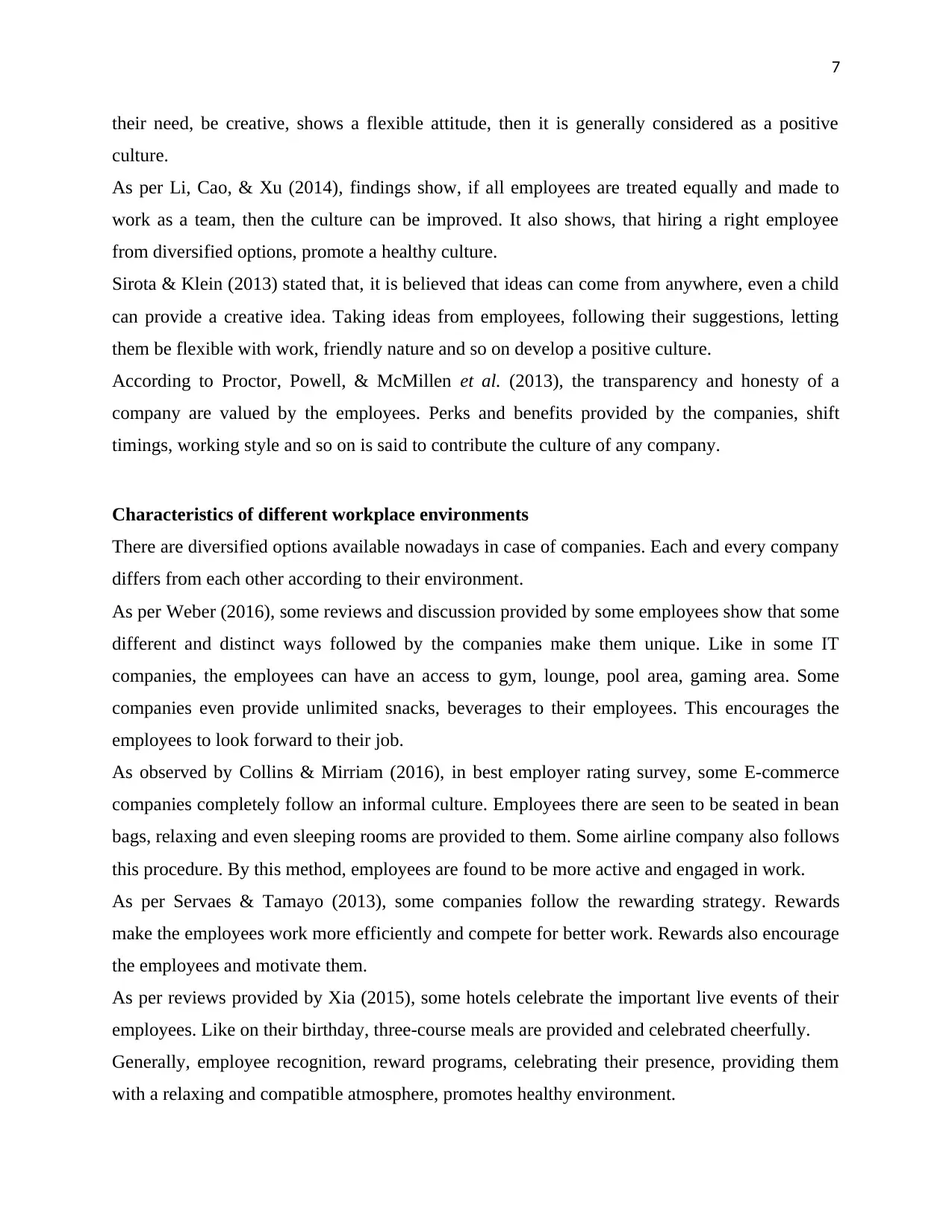
7
their need, be creative, shows a flexible attitude, then it is generally considered as a positive
culture.
As per Li, Cao, & Xu (2014), findings show, if all employees are treated equally and made to
work as a team, then the culture can be improved. It also shows, that hiring a right employee
from diversified options, promote a healthy culture.
Sirota & Klein (2013) stated that, it is believed that ideas can come from anywhere, even a child
can provide a creative idea. Taking ideas from employees, following their suggestions, letting
them be flexible with work, friendly nature and so on develop a positive culture.
According to Proctor, Powell, & McMillen et al. (2013), the transparency and honesty of a
company are valued by the employees. Perks and benefits provided by the companies, shift
timings, working style and so on is said to contribute the culture of any company.
Characteristics of different workplace environments
There are diversified options available nowadays in case of companies. Each and every company
differs from each other according to their environment.
As per Weber (2016), some reviews and discussion provided by some employees show that some
different and distinct ways followed by the companies make them unique. Like in some IT
companies, the employees can have an access to gym, lounge, pool area, gaming area. Some
companies even provide unlimited snacks, beverages to their employees. This encourages the
employees to look forward to their job.
As observed by Collins & Mirriam (2016), in best employer rating survey, some E-commerce
companies completely follow an informal culture. Employees there are seen to be seated in bean
bags, relaxing and even sleeping rooms are provided to them. Some airline company also follows
this procedure. By this method, employees are found to be more active and engaged in work.
As per Servaes & Tamayo (2013), some companies follow the rewarding strategy. Rewards
make the employees work more efficiently and compete for better work. Rewards also encourage
the employees and motivate them.
As per reviews provided by Xia (2015), some hotels celebrate the important live events of their
employees. Like on their birthday, three-course meals are provided and celebrated cheerfully.
Generally, employee recognition, reward programs, celebrating their presence, providing them
with a relaxing and compatible atmosphere, promotes healthy environment.
their need, be creative, shows a flexible attitude, then it is generally considered as a positive
culture.
As per Li, Cao, & Xu (2014), findings show, if all employees are treated equally and made to
work as a team, then the culture can be improved. It also shows, that hiring a right employee
from diversified options, promote a healthy culture.
Sirota & Klein (2013) stated that, it is believed that ideas can come from anywhere, even a child
can provide a creative idea. Taking ideas from employees, following their suggestions, letting
them be flexible with work, friendly nature and so on develop a positive culture.
According to Proctor, Powell, & McMillen et al. (2013), the transparency and honesty of a
company are valued by the employees. Perks and benefits provided by the companies, shift
timings, working style and so on is said to contribute the culture of any company.
Characteristics of different workplace environments
There are diversified options available nowadays in case of companies. Each and every company
differs from each other according to their environment.
As per Weber (2016), some reviews and discussion provided by some employees show that some
different and distinct ways followed by the companies make them unique. Like in some IT
companies, the employees can have an access to gym, lounge, pool area, gaming area. Some
companies even provide unlimited snacks, beverages to their employees. This encourages the
employees to look forward to their job.
As observed by Collins & Mirriam (2016), in best employer rating survey, some E-commerce
companies completely follow an informal culture. Employees there are seen to be seated in bean
bags, relaxing and even sleeping rooms are provided to them. Some airline company also follows
this procedure. By this method, employees are found to be more active and engaged in work.
As per Servaes & Tamayo (2013), some companies follow the rewarding strategy. Rewards
make the employees work more efficiently and compete for better work. Rewards also encourage
the employees and motivate them.
As per reviews provided by Xia (2015), some hotels celebrate the important live events of their
employees. Like on their birthday, three-course meals are provided and celebrated cheerfully.
Generally, employee recognition, reward programs, celebrating their presence, providing them
with a relaxing and compatible atmosphere, promotes healthy environment.
Paraphrase This Document
Need a fresh take? Get an instant paraphrase of this document with our AI Paraphraser
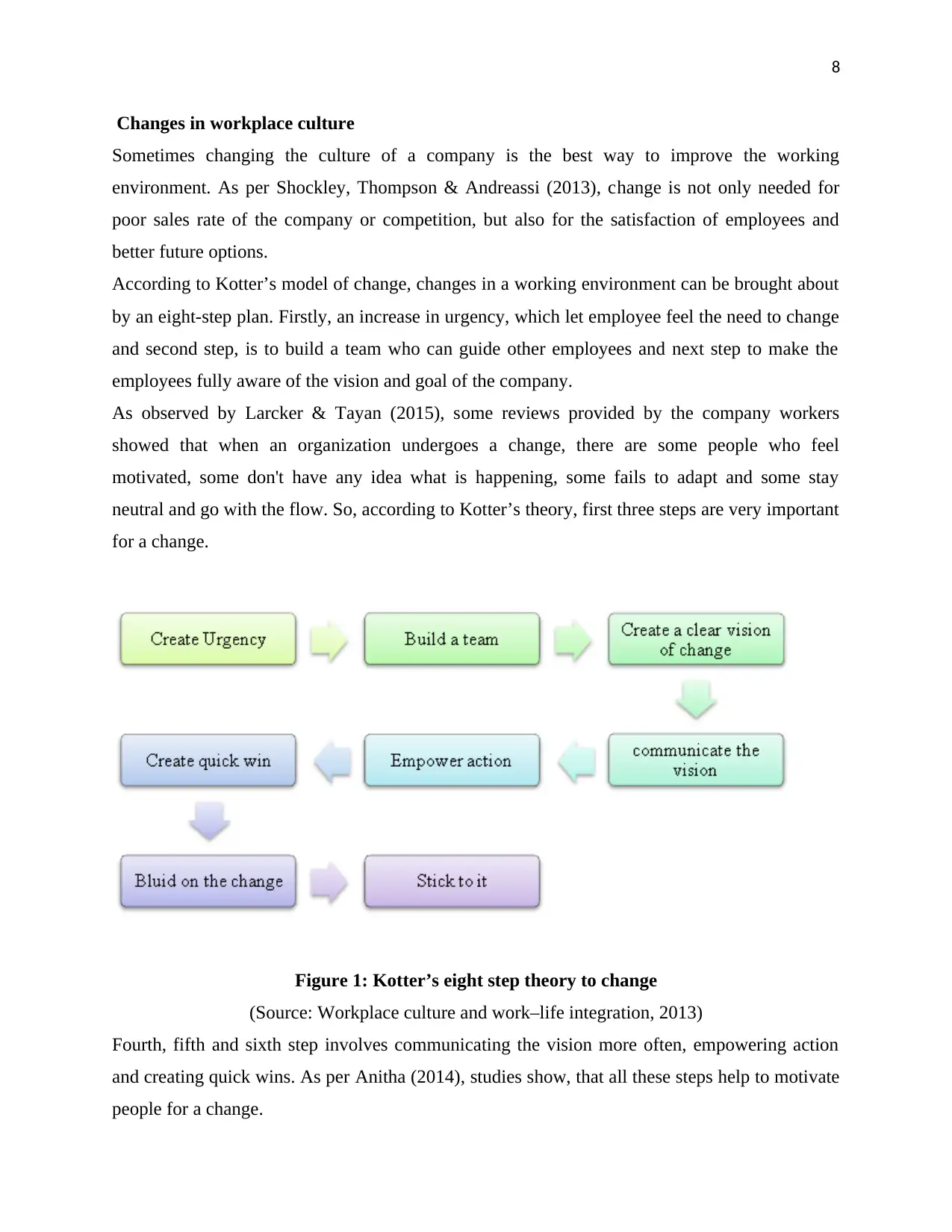
8
Changes in workplace culture
Sometimes changing the culture of a company is the best way to improve the working
environment. As per Shockley, Thompson & Andreassi (2013), change is not only needed for
poor sales rate of the company or competition, but also for the satisfaction of employees and
better future options.
According to Kotter’s model of change, changes in a working environment can be brought about
by an eight-step plan. Firstly, an increase in urgency, which let employee feel the need to change
and second step, is to build a team who can guide other employees and next step to make the
employees fully aware of the vision and goal of the company.
As observed by Larcker & Tayan (2015), some reviews provided by the company workers
showed that when an organization undergoes a change, there are some people who feel
motivated, some don't have any idea what is happening, some fails to adapt and some stay
neutral and go with the flow. So, according to Kotter’s theory, first three steps are very important
for a change.
Figure 1: Kotter’s eight step theory to change
(Source: Workplace culture and work–life integration, 2013)
Fourth, fifth and sixth step involves communicating the vision more often, empowering action
and creating quick wins. As per Anitha (2014), studies show, that all these steps help to motivate
people for a change.
Changes in workplace culture
Sometimes changing the culture of a company is the best way to improve the working
environment. As per Shockley, Thompson & Andreassi (2013), change is not only needed for
poor sales rate of the company or competition, but also for the satisfaction of employees and
better future options.
According to Kotter’s model of change, changes in a working environment can be brought about
by an eight-step plan. Firstly, an increase in urgency, which let employee feel the need to change
and second step, is to build a team who can guide other employees and next step to make the
employees fully aware of the vision and goal of the company.
As observed by Larcker & Tayan (2015), some reviews provided by the company workers
showed that when an organization undergoes a change, there are some people who feel
motivated, some don't have any idea what is happening, some fails to adapt and some stay
neutral and go with the flow. So, according to Kotter’s theory, first three steps are very important
for a change.
Figure 1: Kotter’s eight step theory to change
(Source: Workplace culture and work–life integration, 2013)
Fourth, fifth and sixth step involves communicating the vision more often, empowering action
and creating quick wins. As per Anitha (2014), studies show, that all these steps help to motivate
people for a change.
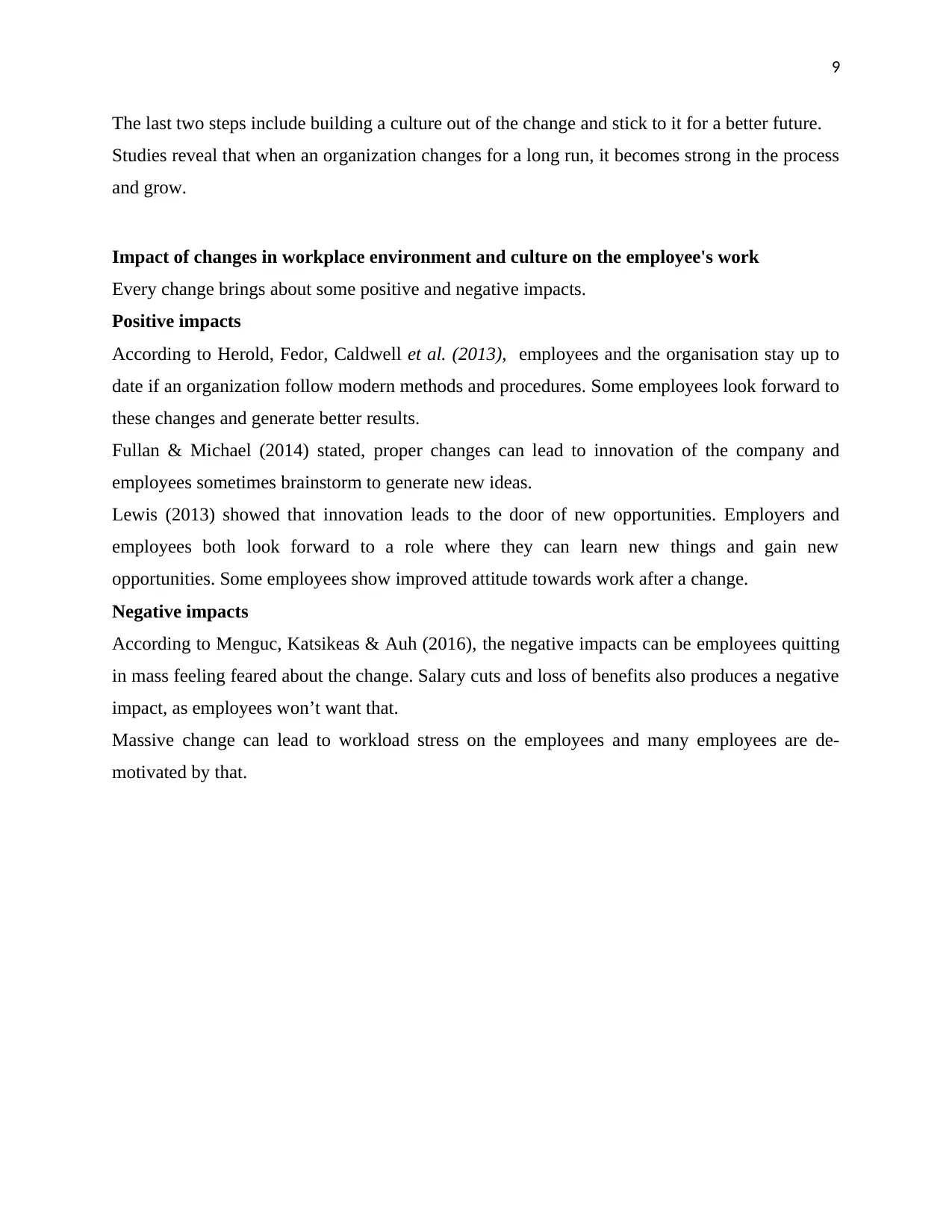
9
The last two steps include building a culture out of the change and stick to it for a better future.
Studies reveal that when an organization changes for a long run, it becomes strong in the process
and grow.
Impact of changes in workplace environment and culture on the employee's work
Every change brings about some positive and negative impacts.
Positive impacts
According to Herold, Fedor, Caldwell et al. (2013), employees and the organisation stay up to
date if an organization follow modern methods and procedures. Some employees look forward to
these changes and generate better results.
Fullan & Michael (2014) stated, proper changes can lead to innovation of the company and
employees sometimes brainstorm to generate new ideas.
Lewis (2013) showed that innovation leads to the door of new opportunities. Employers and
employees both look forward to a role where they can learn new things and gain new
opportunities. Some employees show improved attitude towards work after a change.
Negative impacts
According to Menguc, Katsikeas & Auh (2016), the negative impacts can be employees quitting
in mass feeling feared about the change. Salary cuts and loss of benefits also produces a negative
impact, as employees won’t want that.
Massive change can lead to workload stress on the employees and many employees are de-
motivated by that.
The last two steps include building a culture out of the change and stick to it for a better future.
Studies reveal that when an organization changes for a long run, it becomes strong in the process
and grow.
Impact of changes in workplace environment and culture on the employee's work
Every change brings about some positive and negative impacts.
Positive impacts
According to Herold, Fedor, Caldwell et al. (2013), employees and the organisation stay up to
date if an organization follow modern methods and procedures. Some employees look forward to
these changes and generate better results.
Fullan & Michael (2014) stated, proper changes can lead to innovation of the company and
employees sometimes brainstorm to generate new ideas.
Lewis (2013) showed that innovation leads to the door of new opportunities. Employers and
employees both look forward to a role where they can learn new things and gain new
opportunities. Some employees show improved attitude towards work after a change.
Negative impacts
According to Menguc, Katsikeas & Auh (2016), the negative impacts can be employees quitting
in mass feeling feared about the change. Salary cuts and loss of benefits also produces a negative
impact, as employees won’t want that.
Massive change can lead to workload stress on the employees and many employees are de-
motivated by that.
⊘ This is a preview!⊘
Do you want full access?
Subscribe today to unlock all pages.

Trusted by 1+ million students worldwide
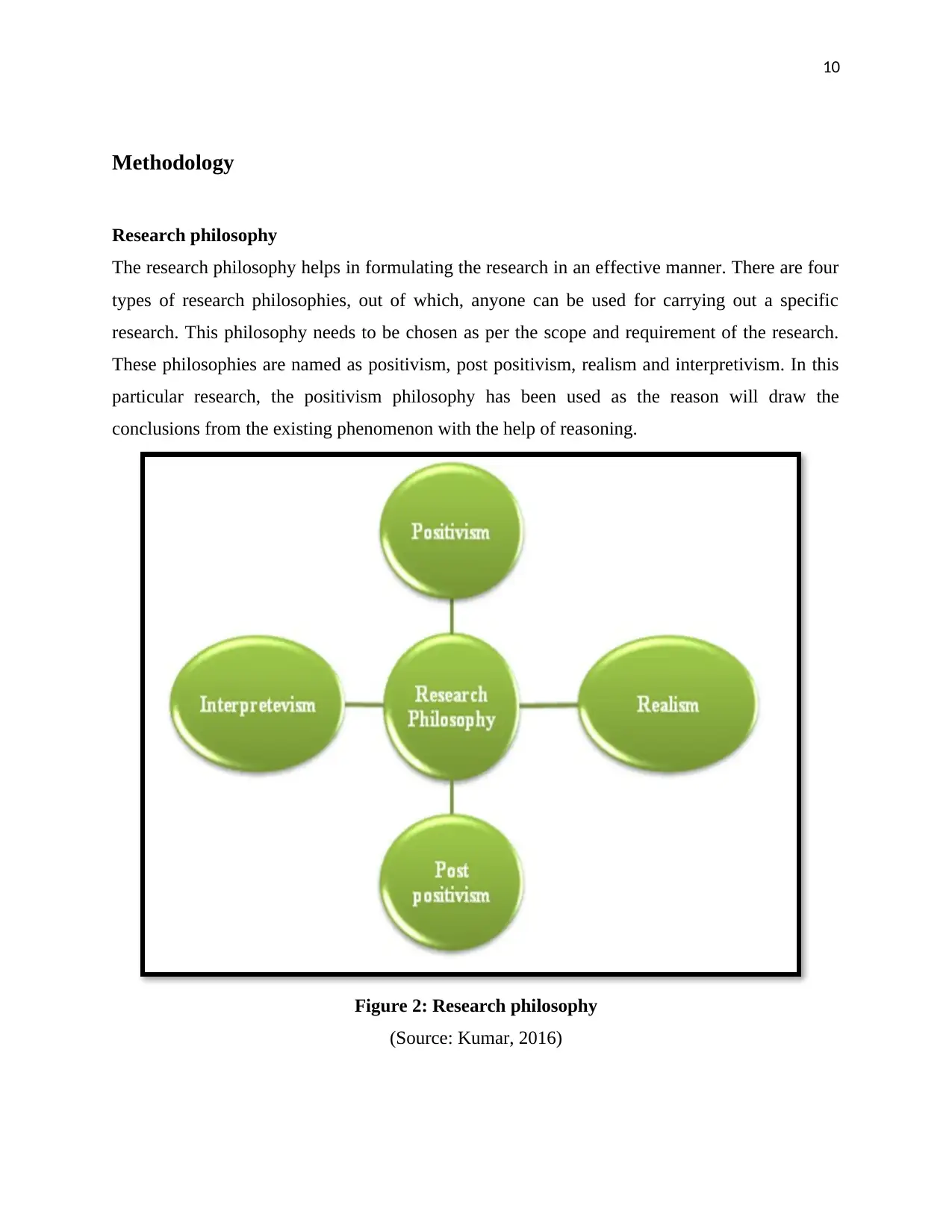
10
Methodology
Research philosophy
The research philosophy helps in formulating the research in an effective manner. There are four
types of research philosophies, out of which, anyone can be used for carrying out a specific
research. This philosophy needs to be chosen as per the scope and requirement of the research.
These philosophies are named as positivism, post positivism, realism and interpretivism. In this
particular research, the positivism philosophy has been used as the reason will draw the
conclusions from the existing phenomenon with the help of reasoning.
Figure 2: Research philosophy
(Source: Kumar, 2016)
Methodology
Research philosophy
The research philosophy helps in formulating the research in an effective manner. There are four
types of research philosophies, out of which, anyone can be used for carrying out a specific
research. This philosophy needs to be chosen as per the scope and requirement of the research.
These philosophies are named as positivism, post positivism, realism and interpretivism. In this
particular research, the positivism philosophy has been used as the reason will draw the
conclusions from the existing phenomenon with the help of reasoning.
Figure 2: Research philosophy
(Source: Kumar, 2016)
Paraphrase This Document
Need a fresh take? Get an instant paraphrase of this document with our AI Paraphraser
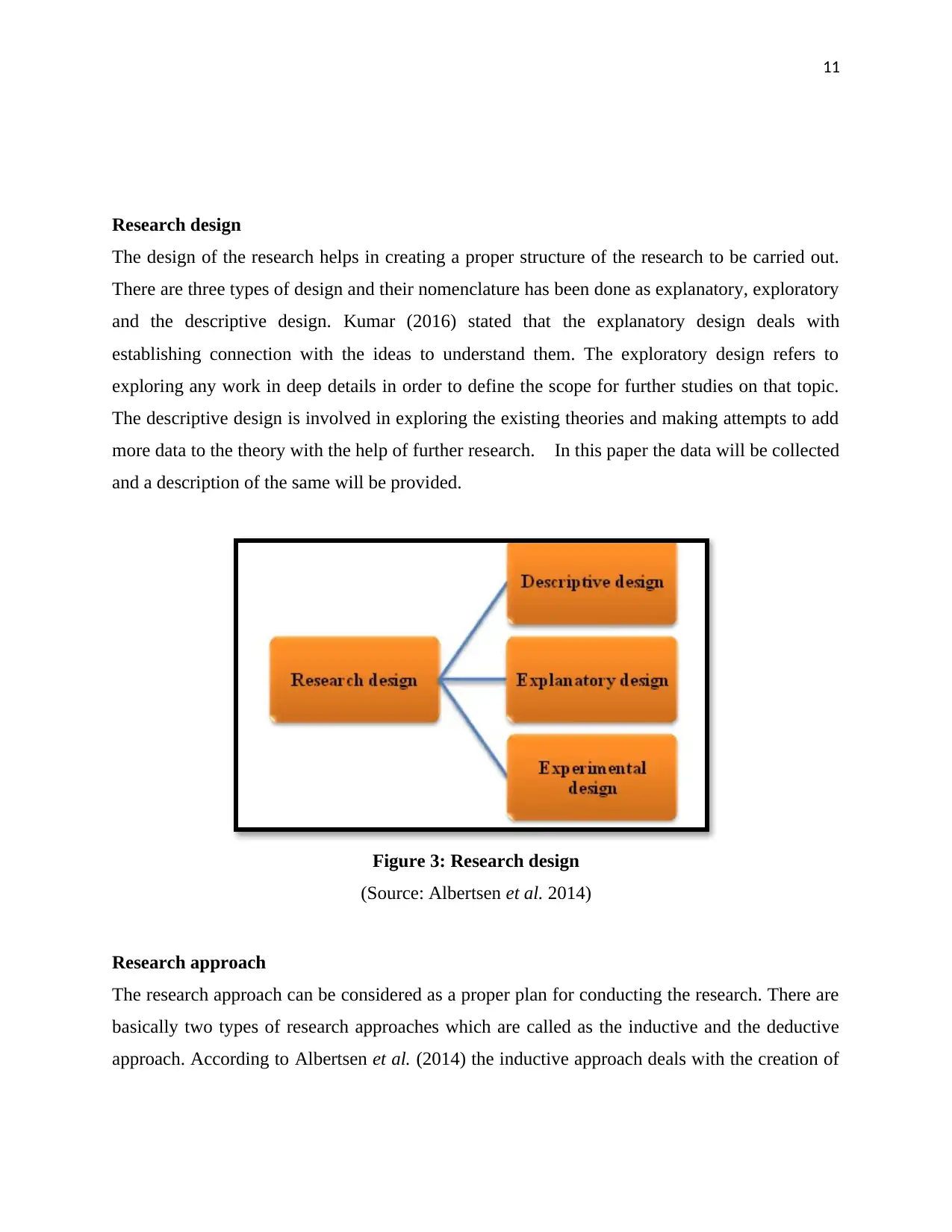
11
Research design
The design of the research helps in creating a proper structure of the research to be carried out.
There are three types of design and their nomenclature has been done as explanatory, exploratory
and the descriptive design. Kumar (2016) stated that the explanatory design deals with
establishing connection with the ideas to understand them. The exploratory design refers to
exploring any work in deep details in order to define the scope for further studies on that topic.
The descriptive design is involved in exploring the existing theories and making attempts to add
more data to the theory with the help of further research. In this paper the data will be collected
and a description of the same will be provided.
Figure 3: Research design
(Source: Albertsen et al. 2014)
Research approach
The research approach can be considered as a proper plan for conducting the research. There are
basically two types of research approaches which are called as the inductive and the deductive
approach. According to Albertsen et al. (2014) the inductive approach deals with the creation of
Research design
The design of the research helps in creating a proper structure of the research to be carried out.
There are three types of design and their nomenclature has been done as explanatory, exploratory
and the descriptive design. Kumar (2016) stated that the explanatory design deals with
establishing connection with the ideas to understand them. The exploratory design refers to
exploring any work in deep details in order to define the scope for further studies on that topic.
The descriptive design is involved in exploring the existing theories and making attempts to add
more data to the theory with the help of further research. In this paper the data will be collected
and a description of the same will be provided.
Figure 3: Research design
(Source: Albertsen et al. 2014)
Research approach
The research approach can be considered as a proper plan for conducting the research. There are
basically two types of research approaches which are called as the inductive and the deductive
approach. According to Albertsen et al. (2014) the inductive approach deals with the creation of
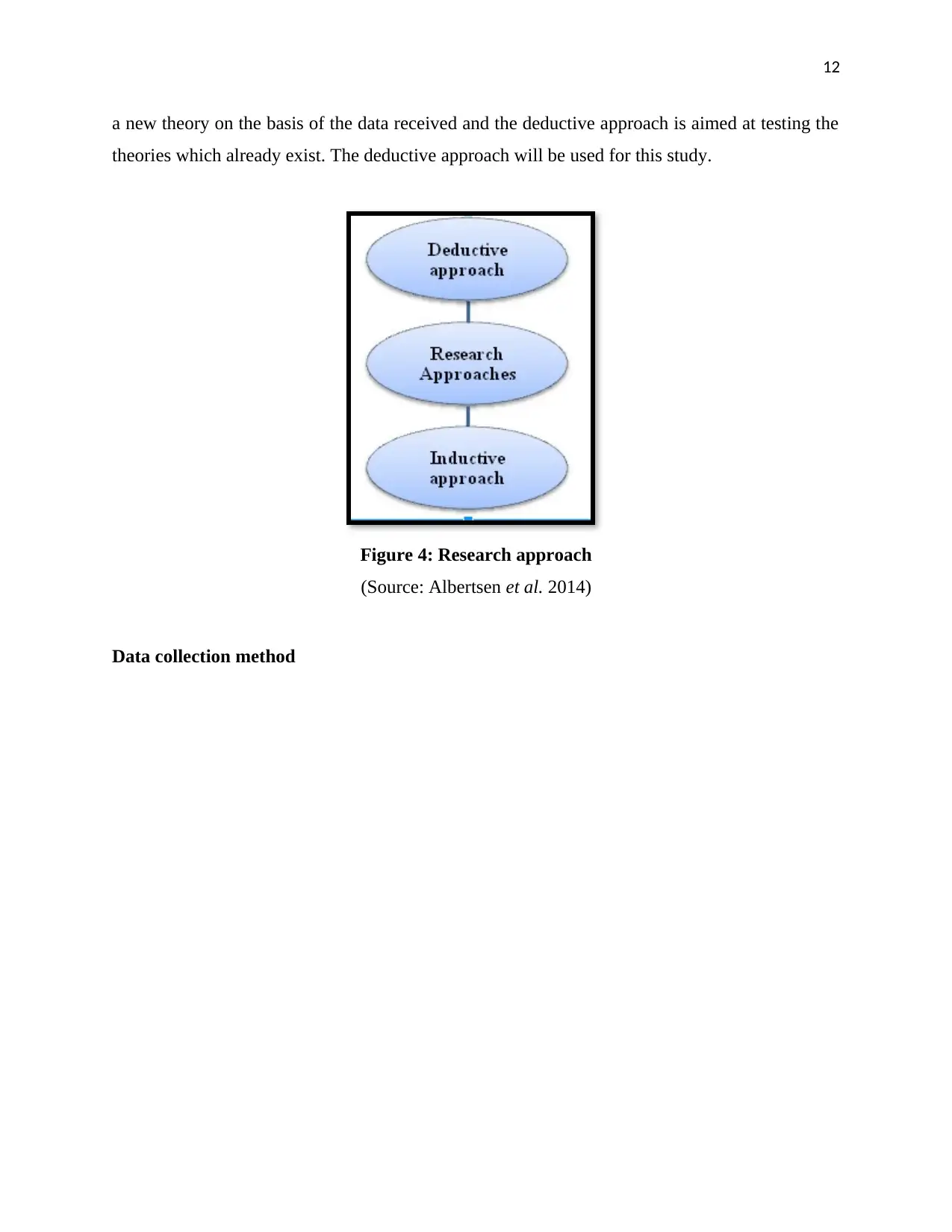
12
a new theory on the basis of the data received and the deductive approach is aimed at testing the
theories which already exist. The deductive approach will be used for this study.
Figure 4: Research approach
(Source: Albertsen et al. 2014)
Data collection method
a new theory on the basis of the data received and the deductive approach is aimed at testing the
theories which already exist. The deductive approach will be used for this study.
Figure 4: Research approach
(Source: Albertsen et al. 2014)
Data collection method
⊘ This is a preview!⊘
Do you want full access?
Subscribe today to unlock all pages.

Trusted by 1+ million students worldwide
1 out of 28
Related Documents
Your All-in-One AI-Powered Toolkit for Academic Success.
+13062052269
info@desklib.com
Available 24*7 on WhatsApp / Email
![[object Object]](/_next/static/media/star-bottom.7253800d.svg)
Unlock your academic potential
Copyright © 2020–2025 A2Z Services. All Rights Reserved. Developed and managed by ZUCOL.





